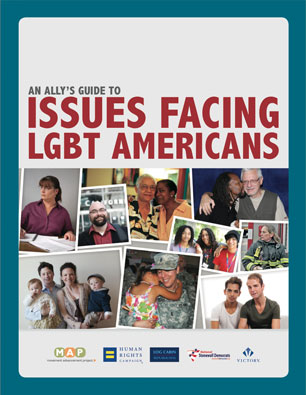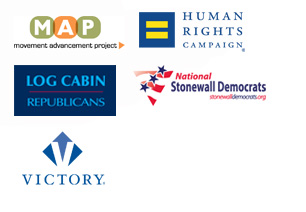The Bottom Line
An Ally’s Guide to Issues Facing LGBT Americans is a primer introducing the major areas in which unfair laws and stigma create extra burdens for LGBT Americans and prevent them from having the chance to pursue health and happiness, earn a living, be safe in their communities, and serve their country. The guide features maps and discussions of federal and state laws that stand in the way of equal opportunity for LGBT Americans. Recent updates incorporate November 2012 election results.
- An Ally's Guide to Issues Facing LGBT Americans Download
Abstract
Despite historic gains in the last few years, LGBT Americans are simply still not treated equally under federal law. Contrary to popular belief, federal legislation does not protect LGBT people from discrimination in housing, public accommodations, credit or employment—and LGBT people also lack such protections in most states. LGBT workers often cannot extend their health insurance coverage to their partners or children. Without family and marriage tax deductions, LGBT families pay additional taxes but lack access to critical protections that many Americans often take for granted, like Social Security Survivor Benefits. Due to these and myriad other inequalities, LGBT people are more likely to live in poverty and suffer from health disparities.
An Ally’s Guide to Issues Facing LGBT Americans provides an overview of key areas that figure into the goal of equal opportunity for LGBT Americans, and state maps that document progress toward achieving:
- The Opportunity to Earn a Living and Provide for Ourselves and Our Families, which requires: fair and inclusive workplaces and access to workplace benefits.
- The Ability to Pursue Health and Happiness, which requires: access to health insurance; physical and mental health; access to competent and welcoming health care providers; access to identity documents needed for daily living; and freedom from discrimination
- The Ability to Take Care of the Ones We Love, which requires: the freedom to marry; secure legal ties between parents and their children; and caring for a sick partner or child.
- The Ability to Be Safe in Our Communities, which requires: inclusive hate crimes laws, safe schools, and welcoming faith communities.
- The Chance to Serve Our Country, including military service and public service.
An Ally’s Guide to Issues Facing LGBT Americans was created by the Movement Advancement Project (MAP), the Human Rights Campaign (HRC), Log Cabin Republicans, National Stonewall Democrats, and the Gay & Lesbian Victory Fund and Institute.
Organizations Working for Change
There are many local, state, and national organizations working to make things better for LGBT people, and change is happening every day. For more about these organizations, visit this Resource Page for an introduction to organizations working to improve the lives of LGBT Americans.



